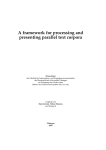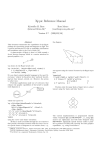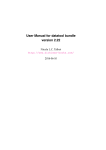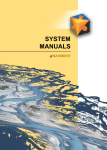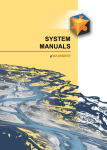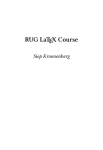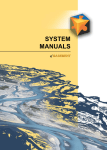Download arydshln-man.
Transcript
The arydshln package∗
Hiroshi Nakashima
(Toyohashi Univ. of Tech.)
2004/08/31
Abstract
This file gives LATEX’s array and tabular environments the capability to draw
horizontal/vertical dash-lines.
Contents
1 Introduction
2 Usage
2.1 Loading Package . . . . . . . . . .
2.2 Basic Usage . . . . . . . . . . . . .
2.3 Style Parameters . . . . . . . . . .
2.4 Fine Tuning . . . . . . . . . . . . .
2.5 Finer Tuning . . . . . . . . . . . .
2.6 Performance Tuning . . . . . . . .
2.7 Compatibility with Other Packages
2
.
.
.
.
.
.
.
.
.
.
.
.
.
.
.
.
.
.
.
.
.
.
.
.
.
.
.
.
.
.
.
.
.
.
.
.
.
.
.
.
.
.
3 Known Problems
∗ This
.
.
.
.
.
.
.
.
.
.
.
.
.
.
.
.
.
.
.
.
.
.
.
.
.
.
.
.
.
.
.
.
.
.
.
.
.
.
.
.
.
.
.
.
.
.
.
.
.
.
.
.
.
.
.
.
.
.
.
.
.
.
.
.
.
.
.
.
.
.
.
.
.
.
.
.
.
.
.
.
.
.
.
.
.
.
.
.
.
.
.
.
.
.
.
.
.
.
.
.
.
.
.
.
.
.
.
.
.
.
.
.
.
.
.
.
.
.
.
2
2
3
3
3
4
5
5
7
file has version number v1.71, last revised 2004/08/31.
1
1
Introduction
In January 1993, Weimin Zhang kindly posted a style hvdashln written by the author,
which draws horizontal/vertical dash-lines in LATEX’s array and tabular environments, to
the news group comp.text.tex. The style, unfortunately, has a known problem that vertical
lines are broken when an array contains tall rows.
In March of the year, Monty Hayes complained of this problem encouraging the author
to make a new version arydshln to solve the problem. The new style also has new features,
such as allowing ‘:’ to specify vertical dash-line in preamble, and \cdashline being a
counterpart of \cline.
In March 1999, Sebastian Rahtz kindly invited the style, which had been improved
following the bug report from Takahiro Kubota, to be included in TEX CTAN and also
in the online catalogue compiled by Graham Williams. This invitation gave the style new
users including Peter Ehrbar who wished to use it with array style in Standard LATEX Tools
Bundle and had trouble because these styles were incompatible with each other. Therefore,
the style became compatible with array and got additional new features.
In February 2000, Zsuzsanna Nagy reported that arydshln is not compatible with colortab
style to let the author work on the compatibility issue again.
In Feburary 2001, Craig Leech reported another compatibility problem with longtable.
Although the author promised that the problem would be attacked some day, the issue had
left long time1 until three other complaints. Then the author attacked the problem hoping
it is the last compatibility issue2 .
In May 2004, Klaus Dalinghaus found another incompatibility with colortbl. Although
he was satisfied by a quick hack for cell painting, the author attacked a harder problem for
line coloring to solve the problem3 .
2
Usage
2.1
Loading Package
The package is usable to both LATEX 2ε and LATEX-2.09 users with their standard package
loading declaration. If you use LATEX 2ε , simply do the following.
\usepackage{arydshln}
If you still love LATEX-2.09, the following is what you have to do.
\documentstyle[..,arydshln,...]{hstylei}
Only one caution given to users of array (v2.3m or later) and longtable (v4.10 or later)
packages, included in Standard LATEX Tools Bundle, and colortab and colortbl package is
that arydshln has to be loaded after array, longtable, colortab and/or colortbl done. That is,
the following is correct but reversing the order of \usepackage will cause some mysterious
error.
\usepackage{array}
% and/or
\usepackage{longtable} % and/or
\usepackage{colortab} % or
\usepackage{colortbl}
\usepackage{arydshln}
1 Two
years and a half! Sorry Craig.
his hope was dashed as described below.
3 Without dreaming it is the last compatibility issue.
2 But
2
2.2
array
tabular
:
\hdashline
\cdashline
Basic Usage
You can simply use array or tabular(*) environments with standard preamble, such as
{r|c|ll}, and standard commands \\, \hline, \cline and \multicolumn.
Drawing a vertical dash-line is quite simple. Use ‘:’ in the preamble as the separator
of columns separated by the dash-line, just like using ‘|’ to draw a vertical solid-line.
The preamble means not only that of the environment, but also the first argument of
\multicolumn.
It is also simple to draw a horizontal dash-line. Use \hdashline and \cdashline as
the counterparts of \hline and \cline.
For example;
\begin{tabular}{|l::c:r|}\hline
A&B&C\\\hdashline
AAA&BBB&CCC\\\cdashline{1-2}
\multicolumn{2}{|l:}{AB}&C\\\hdashline\hdashline
\end{tabular}
will produce the following result.
A
AAA
AB
\firsthdashline
\lasthdashline
Style Parameters
You have two style parameters to control the shape of dash-lines: \dashlinedash is for the
length of each dash segment in a dash line; \dashlinegap controls the amount of each gap
between dash segments. Both parameters have a common default value, 4 pt.
2.4
;
C
CCC
C
If you use array, the dashed version of \firsthline and \lasthline named \first
hdashline and \lasthdashline are available.
2.3
\dashlinedash
\dashlinegap
B
BBB
Fine Tuning
Although you can control the shape of dash-lines in an array/tabular environment as
described in §2.3, you might want to draw a dash-line of a shape different from others. To
specify the shape of a vertical dash-line explicitly, you may use;
;{hdashi/hgapi}
\hdashline
\cdashline
instead of ordinary ‘:’ and will have a dash-line with dash segments of hdashi long separated
by spaces of hgapi.
As for horizontal dash-lines, explicit shape specifications may be given through optional
arguments of \hdashline and \cdashline as follows.
\hdashline[hdashi/hgapi]
\cdashline{hcol1 i-hcol2 i}[hdashi/hgapi]
For example;
\begin{tabular}{|l::c;{2pt/2pt}r|}\hline
A&B&C\\\hdashline[1pt/1pt]
AAA&BBB&CCC\\\cdashline{1-2}[.4pt/1pt]
\multicolumn{2}{|l;{2pt/2pt}}{AB}&C\\\hdashline\hdashline
\end{tabular}
3
will produce the following result.
A
AAA
AB
\ADLnullwide
\ADLsomewide
B
BBB
C
CCC
C
The vertical solid and dashed lines are drawn as if their width is zero, as standard
LATEX’s array and tabular do, if you don’t use array package. Otherwise, they have real
width of \arrayrulewidth as the authors of array prefers. However, you may explicitly
tell arydshln to follow your own preference by \ADLnullwide if you love LATEX standard, or
\ADLsomewide if you second the preference of array authors.
2.5
Finer Tuning
To draw dash-lines, we use a powerful primitive of TEX called \xleaders. It replicates a
segment that consist of a dash and gap so that a dash-line has as many segments as possible and distributes remainder space to make the spaces between adjacent dash segments
(almost) equal to each other. Therefore, you will have dash-lines with consistent steps of
gaps and spaces as the left and upper lines in Figure 1(1) are.
However, because of a bug (or buggy feature) of \xleaders, there is a small possibility that a dash segment near the right/bottom end drops as right and lower lines in (1)
of the figure shows. To cope with this problem, you may change the drawing mode by
\ADLdrawingmode{hmi} as follows.
\ADLdrawingmode
• m=1
As shown in Figure 1(1), most beautiful in almost all cases as the left/upper lines, but
has a small possibility to produce an ugly result as right/lower lines. This is default.
• m=2
As shown in (2) of the figure, beautiful if dash-lines are not so sparse as right/lower
lines, but dash segments near the both ends may be a little bit too long as left/upper
lines.
• m=3
As shown in (3) of the figure, beautiful if dash-lines are not so sparse as right/lower
lines, but gaps near the both ends may be considerably too large as left/upper lines.
It is recommended to use default mode 1 unless you have an ugly result in the final version
of your manuscript, because the correctness of mode 1 is very sensitive to the length of
dash-lines.
A
A
A
A
A
A
A
A
A
B
B
B
B
B
B
B
B
B
C
C
C
C
C
C
C
C
C
(1)
(2)
(3)
Figure 1: Drawing mode controlled by \ADLdrawingmode
4
2.6
\ADLinactivate
\ADLactivate
Array
Tabular
Performance Tuning
Since drawing dash-lines is a hard job, you have to be patient with the fact that the
performance of typesetting array/tabular with dash-lines is poorer than that of ordinary
ones. In fact, according to author’s small performance evaluation with a tabular having
nine vertical and ten horizontal dash-lines, typesetting the tabular is approximately ten
times as slow as its ordinary counterpart with solid lines.
However, this is not a really bad news, unfortunately. The real one is that loading
arydshln makes typesetting array/tabular slower even if they only have solid lines which
the package treats as special ones of dash-lines. The evaluation result shows the degradation
factor is about nine. Therefore, if your document has many array/tabular with solid lines,
LATEX will run slowly even with quite few (or no) array/tabular with dash-lines,
To cope with this problem, you may inactivate dash-line functions by the command
\ADLinactivate that replaces dash-lines with solid lines drawn by a faster (i.e. ordinary)
mechanism. Although the inactivation does not completely solve the performance problem,
the degradation factor will become much smaller and acceptable, approximately 1.5 in
the author’s evaluation. For example, the draft version of your document will have the
command in its preamble, which you will remove from your final version.
Alternatively, you may do \ADLinactivate in the preamble, switch on by \ADLactivate
before you really need dash-lines, and switch off again afterword. A wiser way could be
surrounding array/tabular by \begin{ADLactivate} and \end{ADLactivate}.
If you feel it tiresome to type the long command/environment name for the activation,
you may use Array and Tabular(*) environment in which dash-line functions are always
active. Note that, however, since these environment names are too natural to keep them
from being used by authors of other packages or yourself, name conflict could occur. If
Array and/or Tabular have already been defined when arydshln is loaded, you will get a
warning to show you have to define new environments, say dlarray and dltabular, as
follows.
\newenvironment{dlarray}{\ADLactivate\begin{array}}%
{\end{array}}
\newenvironment{dltabular}{\ADLactivate\begin{tabular}}%
{\end{tabular}}
\newenvironment{dltabular*}{\ADLactivate\begin{tabular*}}%
{\end{tabular*}}
\ADLnoshorthanded
On the other hand, if they are defined after arydshln is loaded, their definitions are
silently replaced or LATEX complains of multiple definitions. The error in the latter case
will be avoided by putting \ADLnoshorthanded just after \usepackage{arydshln}.
2.7
Compatibility with Other Packages
Users of array package may use all of newly introduced preamble characters, such as ‘>’, ‘<’,
‘m’, ‘b’, and all the commands such as \extrarowheight, \firsthilne and \lasthline.
The preamble characters given by arydshln may be included in the second argument of
\newcolumntype.
Also users of colortab package may use \LCC/\ECC construct to color columns. A horizontal solid/dash line may be colored by, e.g. \NAC\hdashline\ENAC. The pair of \AC and
\EAC may be used to color everything between them but, unfortunately, vertical lines are
not. There are no ways to color vertical lines in a table having dash lines. You may color
vertical lines of a ordinary table inactivating dash line functions by \ADLinactivate.
5
Another (and more convenient) table coloring tool colortbl may be also used simply by
loading it before arydshln. Not only the painting commands \rowcolor, \columncolor and
\cellcolor work well, but both solid and dash lines are also colored by the command
\arrayrulecolor of colortbl4 . One caution is that \arrayrulecolor defines the color of
the dash-part of dash lines and thus gap-part has no color (i.e. color of the paper on which
the line drawn). Therefore, if you have a tabular like;
\begin{tabular}{|>{\columncolor{red}}l:>{\colomncolor{green}}r|}
...
\end{tabular}
\ADLnullwidehline
\ADLsomewidehline
\dashgapcolor
\nodashgapcolor
you will find the vertical dash line is a sequence of black (or the color of \arrayrulecolor)
and white segments. This problem is partly solved by declaring \ADLnullwide5 to conjunct
the red and blue columns and to draw the dash line on their border.
Unfortunately, however, \ADLnullwide does not affect the real width of horizontal
(dash) lines and thus you will still see white gaps in \hdashline and \cdashline. A
solution is to put \ADLnullwidehline before you start a array/tabular6 . With this
command, a horizontal (dash) line is drawn adjusting its bottom edge to that of the row
above. The command \ADLsomewidehline turns the switch to default and the top edge of
a horizontal (dash) line will be adjusted to the bottom edge of the row above.
Another method to avoid white gaps is to give a color to gaps by \dashgapcolor with
arguments same as \color. For example;
\arrayrulecolor{green}\dashgapcolor[rgb]{1,1,0}
longtable
Longtable
makes colorful dash lines with green dashes and yellow gaps. The command can be placed
outside of array/tabular for dash lines in the environment, in the argument of preamble character > for vertical dash lines following them, or at the beginning of a row for
horizontal dash lines following the command. The commmand \nodashgapcolor (no arguments) nullifies the effect of \dashgapcolor. Note that \nodashgapcolor is different from
\dashgapcolor{white} because the former makes gaps transparent while the later whiten
them.
Usage of longtable with arydshln is quite simple. Just loading arydshln after longtable is
enough to make the longtable environment able to draw dash-lines. A shorthand activation
of dash-line functions is also available by Longtable environment. One caution to longtable
users is that the temporary results before the convergence of the column widths may be
different from those without arydshln. For example, the following is the first pass result of
the example shown in Table 3 of the longtable manual.
1 2 3
wide multicolumn spanning 1–3
multicolumn 1–2
3
wide 1
2
3
Since LTchunksize is one in the example, columns of each row has their own widths and
thus has vertical lines drawn at the edges of the columns. On the other hand, you will have
the following as the first pass result with arydshln.
4 The colortbl manual says \arrayrulecolor and \doublerulesepcolor may be in >{...} in a preamble
but they cause an error with the original implementation. This bug is fixed in arydshln and they are now
usable to specify the color of the vertical (dash) lines whose specifications occur after the commands.
5 Since colortbl automatically loads array, the default is \ADLsomewide
6 This command also makes \cline and \cdashline visisble even if the row below is painted.
6
1 2 3
wide multicolumn spanning 1–3
multicolumn 1–2
3
wide 1
2
3
As you see, the vertical lines are drawn at the column edges of the last row7 because arydshln
draws them when it see the last row. Anyway, you may ignore temporary results and will
have a compatible result when the column widths are converged like the following.
1
2
3
wide multicolumn spanning 1–3
multicolumn 1–2
3
wide 1
2
3
3
Known Problems
There are following known problems.
1. The new preamble specifiers ‘:’ and ‘;{hdashi/hgapi}’ cannot be followed or preceded
by ‘@{htexti}’, or you will have an ugly result. More specifically, a specifier to draw
a dash-line at the left edge of a column cannot be preceded by ‘@{htexti}’, while that
to draw at the right edge cannot be followed by ‘@{htexti}’.
2. If you use array package, the restriction of ‘@’ shown above is also applied to ‘!’.
3. In order to make it sure that a dash-line always touches its both end, i.e. a dash-line
always begins and ends with a dash segment, the amount of a gap will slightly vary
depending on the dash-line length.
4. As described in §2.5, dash-lines drawn in the default mode 1 may lack a dash segment
near its right/bottom end.
5. If a dash-line is too short, you will have an ugly result without overfull message. More
specifically, in mode 1 or 3, a line will look to protrude beyond its column/row borders
if it is shorter than a half of \dashlinedash. In mode 2, the minimum length to avoid
the protrusion is 1.5 × \dashlinedash + \dashlinegap.
6. As described in §2.6, the processing speed for array and tabular environment will
become slower even if dash-lines are not included.
7. As described in §2.7, \AC and \EAC pair of colortab such as \AC&\EAC cannot color
the vertical line at &. Use \ADLinactivate if you want to have a ordinary table with
colored vertical lines. Note that you may color vertical lines with colortbl package.
Acknowledgments
The author thanks to Monty Hayes who gave the author the opportunity to make this style,
and Weimin Zhang and Takahiro Kubota who pointed out bugs in early versions. He also
7 More precisely, drawn according to the column widths established by all the chunks preceding page
output.
7
thanks to the following people; Sebastian Rahtz and Graham Williams who kindly invited
the style to TEX CTAN and online catalogue compiled by Graham; Peter Ehrbar who
showed the style was incompatible with array and kindly accepted the offer to be an alphauser of v1.4 alone; Zsuzsanna Nagy who reported another incompatibility problem with
colortab; Ralf Heydenreich who reported the bug causing that glues in a column have no
effect; Yaxin Liu who reported the incompatibility bug of array and \ADLinactivate; Craig
Leech who reported the incompatibility problem with longtable, which was also reported
by Uwe Jehmlich, Torge Thielemann and Florian Weig, and have waited for two years and
a half (!) for the solution; and Klaus Dalinghaus who reported yet another incompatibility
with colortbl; Morten Høgholm who reported the bug of m-type columns of array which had
not manifested in five (!!) years since the author realesed the first array-compatible version.
The base implementation of array and tabular environments, part of which the author
gives new definitions referring original ones, are written by Leslie Lamport as a part of
LATEX-2.09 and LATEX 2ε (1997/12/01) to which Johannes Braams and other authors also
contributed. The author also refers array package (v2.3m) written by Frank Mittelbach and
David Carlisle; colortab package (v0.9) written by Timothy van Zandt; and longtable (v4.10)
and colortbl (v0.1j) packages written by David Carlisle; to make the style compatible with
those packages.
8
Index
Italicized number refers to the page where the specification of corresponding entry is described.
Symbols
: ............................... 3
; ............................... 3
\AC . . . . . . . . . . . .
\ADLactivate . . . . .
\ADLdrawingmode . .
\ADLinactivate . . .
\ADLnoshorthanded
\ADLnullwide . . . . .
\ADLnullwidehline
\ADLsomewide . . . . .
\ADLsomewidehline
Array (environment)
array (environment)
array (package) . . .
\arrayrulecolor . .
\arrayrulewidth . .
\cdashline . . . . .
\cellcolor . . . . .
\cline . . . . . . . . .
\color . . . . . . . . .
colortab (package)
colortbl (package)
\columncolor . . . .
counters:
LTchunksize . .
.
.
.
.
.
.
.
A
...
...
...
...
...
...
...
...
...
...
...
...
...
...
.
.
.
.
.
.
.
.
.
.
.
.
.
.
.
.
.
.
.
.
.
.
.
.
.
.
.
.
.
.
.
.
.
.
.
.
.
.
.
.
.
.
.
.
.
.
.
.
.
.
.
.
.
.
.
.
.
.
.
.
.
.
.
.
.
.
.
.
.
.
.
.
.
.
.
.
.
.
.
.
.
.
.
.
.
.
.
.
.
.
.
.
.
.
.
.
.
.
.
.
.
.
.
.
.
.
.
.
.
.
.
.
.
.
.
.
.
.
.
.
.
.
.
.
.
.
.
.
.
.
.
.
.
.
.
.
.
.
.
.
.
.
.
.
.
.
.
.
.
.
.
.
.
.
.
.
.
.
.
.
.
.
.
.
.
.
.
.
.
.
.
.
.
.
.
.
.
.
.
C
...
...
...
...
...
...
...
.
.
.
.
.
.
.
.
.
.
.
.
.
.
.
.
.
.
.
.
.
.
.
.
.
.
.
.
.
.
.
.
.
.
.
.
.
.
.
.
.
.
.
.
.
.
.
.
.
.
.
.
.
.
.
.
.
.
.
.
.
.
.
.
.
.
.
.
.
.
.
.
.
.
.
.
.
.
.
.
.
.
.
.
.
.
.
.
....
....
....
...
.
.
.
.
.
.
.
.
.
.
.
.
.
.
.
.
.
.
.
.
.
.
.
.
.
.
.
.
.
.
.
.
.
.
.
.
.
.
.
.
.
.
.
.
.
.
.
.
.
.
.
.
.
.
.
.
.
.
.
.
.
.
.
.
.
.
.
.
.
.
.
.
.
.
.
.
.
.
.
.
.
.
.
.
.
.
.
.
.
.
.
.
.
.
.
.
.
.
.
.
.
.
.
.
.
.
.
.
.
.
.
.
.
.
.
.
.
.
.
.
.
.
.
.
.
3
6
3
5
H
\hdashline . . . . . . . . . . . . . . . . . . . . . . . 3
\hline . . . . . . . . . . . . . . . . . . . . . . . . . . . 3
L
\lasthdashline . . . . . .
\lasthline . . . . . . . . .
\LCC . . . . . . . . . . . . . . .
Longtable (environment)
longtable (environment)
longtable (package) . . .
LTchunksize (counter) .
. 3
. 5
. 3
. 6
2, 5
2, 5
.. 5
.
.
.
.
.
.
.
.
.
F
\firsthdashline . . . . . . . . . . . . . . . . . . . 3
\firsthline . . . . . . . . . . . . . . . . . . . . . . . 5
. 5
. 5
. 4
. 5
. 5
. 4
. 6
. 4
. 6
. 5
. 3
2, 5
.. 5
.. 4
....
....
....
...
...
....
....
.
.
.
.
.
.
.
.
.
.
.
.
.
.
.
.
.
.
.
.
.
.
.
.
.
.
.
.
.
.
.
.
.
.
.
.
.
.
.
.
.
.
.
.
.
.
.
.
.
.
.
.
.
.
.
.
.
.
.
.
.
. 3
. 5
. 5
. 6
. 6
2, 6
.. 6
M
\multicolumn . . . . . . . . . . . . . . . . . . . . . . 3
N
\NAC . . . . . . . . . . . . . . . . . . . . . . . . . . . . . 5
\newcolumntype . . . . . . . . . . . . . . . . . . . . 5
\nodashgapcolor . . . . . . . . . . . . . . . . . . . 6
.................. 6
D
\dashgapcolor . . . . . . .
\dashlinedash . . . . . . .
\dashlinegap . . . . . . . .
\documentstyle . . . . . .
\doublerulesepcolor . .
\EAC . . . . . . .
\ENAC . . . . . .
environments:
Array . . .
Longtable
Tabular .
array . . . . .
longtable . .
tabular . . .
\extrarowheight
P
packages:
array . . .
colortab
colortbl
longtable
6
3
3
2
5
.
.
.
.
.
.
.
.
.
.
.
.
.
.
.
.
.
.
.
.
.
.
.
.
.
.
.
.
.
.
.
.
.
.
.
.
.
.
.
.
.
.
.
.
.
.
.
.
.
.
.
.
.
.
.
.
.
.
.
.
.
.
.
.
.
.
.
.
.
.
.
.
.
.
.
.
.
.
.
.
2,
2,
2,
2,
5
5
5
6
R
\rowcolor . . . . . . . . . . . . . . . . . . . . . . . . 5
E
...................... 5
...................... 5
T
Tabular (environment) . . . . . . . . . . . . . . . 5
tabular (environment) . . . . . . . . . . . . . . . 3
...................... 5
...................... 6
...................... 5
U
\usepackage . . . . . . . . . . . . . . . . . . . . . . . 2
9










